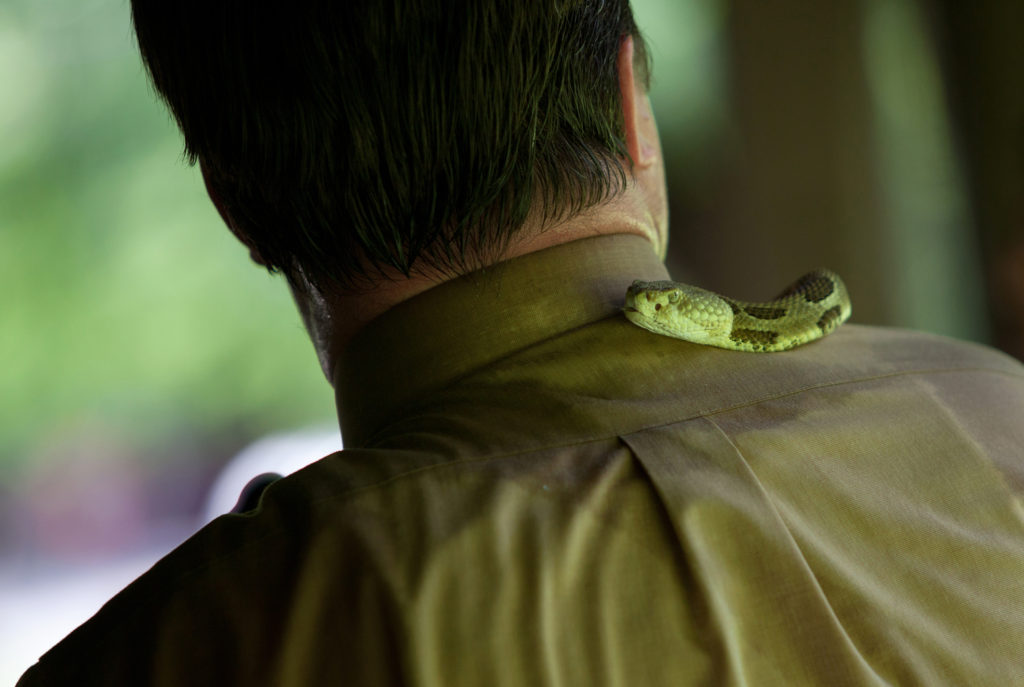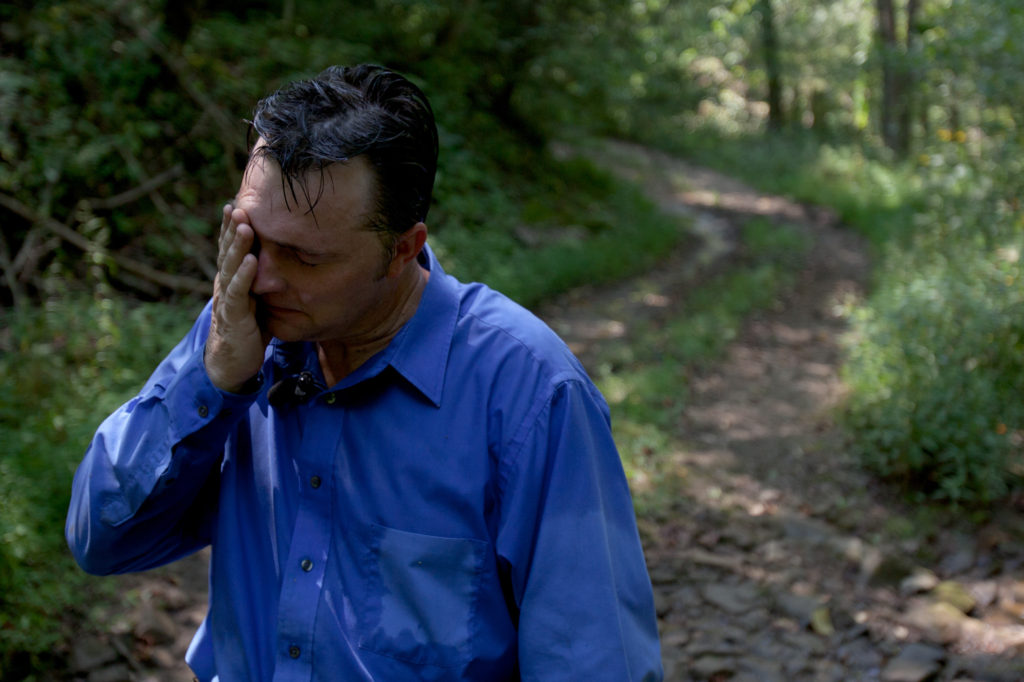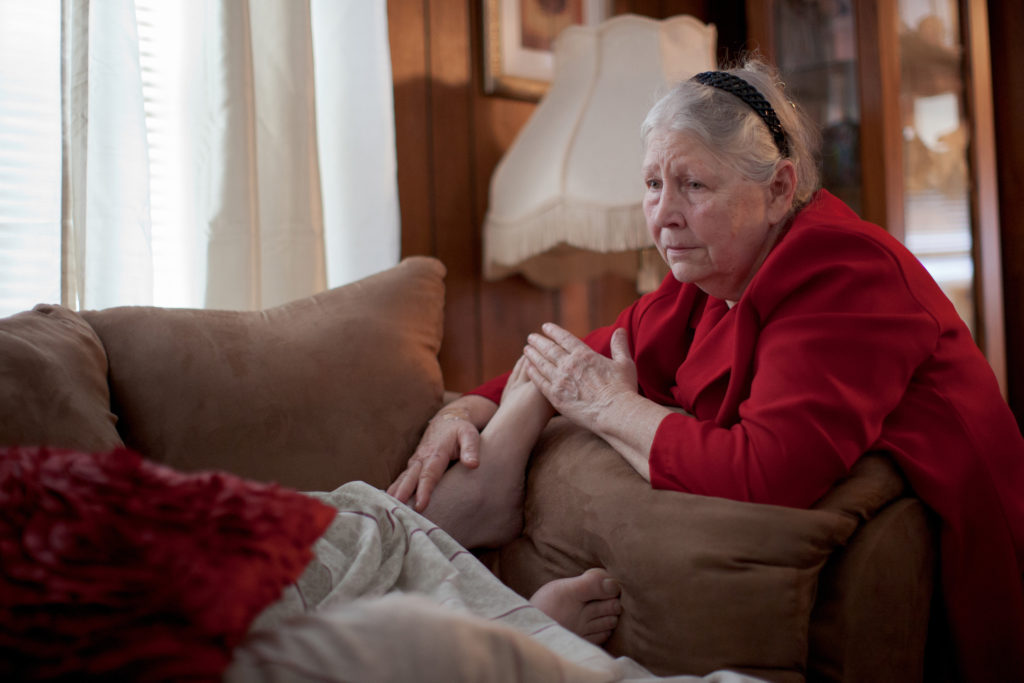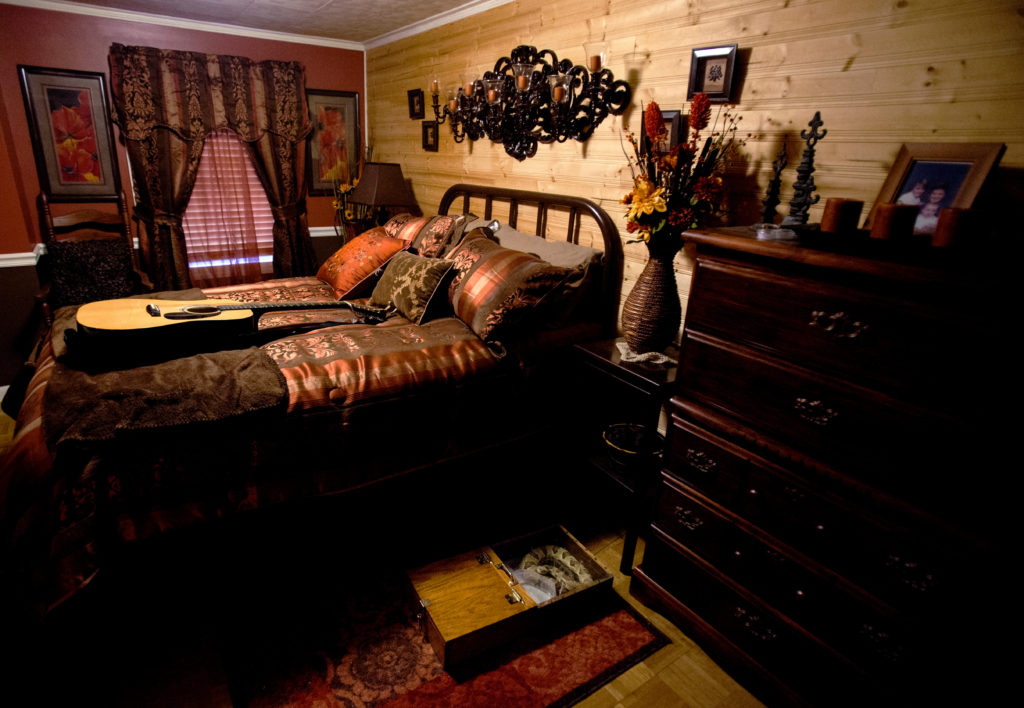Test of Faith: A Conversation with Photographer Lauren Pond
Lauren Pond speaks about her new book Test of Faith: Signs, Serpents, Salvation

Serpent-handler pastor Randy “Mack” Wolford handles a venomous yellow timber rattlesnake during an outdoor homecoming worship service. Wolford devoted his life to keeping the Signs Following Faith alive and spreading it to new areas. (Photograph by Lauren Pond)
Lauren Pond‘s book Test of Faith: Signs, Serpents, Salvation (Duke University Press, November 2017) provides a deeply nuanced, personal look at serpent handling that not only invites greater understanding of a religious practice that has long faced derision and criticism; it also serves as a meditation on the photographic process, its ethics, and its capacity to generate empathy. Here, she speaks with The Revealer‘s editor, Kali Handelman, about the project and her ongoing work.
Revealer: How did you start out as a photographer?
I went to college to study print journalism. While I was there, I joined the college newspaper, The Daily Northwestern, as a beat reporter, and I often ended up shooting photos to accompany my written stories. I found that I really enjoyed doing this, so I started spending time with staff photographers, who taught me more about how to shoot and use different kinds of gear. That’s how I got my start, anyway; from there, I practiced a lot on my own and was eventually able to get photography internships and freelance assignments. I later went to graduate school to study photojournalism.
But more broadly speaking, I think I’ve always been a storyteller at heart, and the camera is a particularly powerful means to tell stories. There can be an immediacy and intimacy to photographs that you don’t always get with writing. I think I naturally gravitated toward photography for this reason.
Revealer: What has drawn you to religious subjects (in the sense, both, of people and of the topic)?
Some people think it’s ironic that I focus on religion, because I don’t come from a strong religious background, and I’m not religious myself. But I honestly think that’s why I’m drawn to religion: I’m curious about what’s unfamiliar to me. I’ve always wanted to understand what different people believe and why, and how belief shapes life and culture. When I picked up a camera, photography became my way of exploring these things.
I also think I just enjoy forming relationships with people of backgrounds different from my own. Doing so and documenting our shared experiences is a really rewarding process. And I hope that by capturing these different communities on a personal, human level, I can help others appreciate them, too.

Pastor Mack Wolford on a serpent hunt during a documentary film shoot, near Jolo, West Virginia, 2011. (Photograph by Lauren Pond)
Revealer: What drew you to the Signs Followers as subjects/ a subject?
I read about serpent handling in an anthropology class in 2010, and I was immediately captivated. Initially, I think this was mostly shock and mystery, as it is for many people. I had no idea that a practice like this existed in the United States, or how people were able to handle venomous snakes and remain unharmed. Also, not coming from a religious background, the idea that people would willingly risk their lives for their beliefs boggled my mind. I wanted to know more about this practice and why people did it.
At the same time, I was also pretty dissatisfied with existing coverage of serpent handling. All of the media clips I found seemed to focus on the snakes, with little information about cultural or environmental context. I wanted to know who the Signs Followers themselves were, and how their beliefs intersected with their lives. I could sense that there was a deeper story. Mack Wolford and his family were grateful for my interest, and welcomed me into their lives to document.
Mack’s death ultimately brought me a lot closer to the Wolfords and the Signs Following community. Sharing that difficult and intimate of an experience, you can’t help but bond. It’s a rich, meaningful relationship that I look forward to preserving.
Revealer: There were some big ethical dilemmas you encountered in making this work, I wonder if you could talk about that and share a bit of where you are now with those questions, now that the book is out?
Yes, there were definitely some major ethical dilemmas.
The first was the issue of whether or not to seek medical attention for Mack after he was bitten by the rattlesnake. At the time, I understood that Mack, like many serpent handlers, did not believe in seeking medical care for snake bites received during worship; he believed that if he was bitten while enacting the Word of God, then it was up to God to decide his fate. Like numerous other people there that day, including filmmakers and Mack’s family and friends, I did not call paramedics, because I did not feel it was my place. Mack was a competent adult who made a conscious decision not to seek care.
In retrospect, I still don’t think it would have been right for me to try to force medical treatment – to prioritize my own value system over his beliefs. However, if I were ever in a similar situation again, I would still make sure to have a discussion with family members about the person’s medical wishes and any potential options. Not long ago, I heard a Signs Following pastor say that if anyone were bitten at his church, he’d call paramedics; the victim could still decline treatment, but medical care would be available if desired. So that’s a possibility that has crossed my mind as well.
The other big ethical dilemma involved photographs of Mack’s death. When Mack was suffering at home after the snakebite, I photographed him without his shirt on, which his wife had asked me not to do. Pentecostal Holiness culture is very modest, and to be shirtless is essentially to be naked – but I did not understand this. At the time when I took these photos, I had been uncomfortably standing there and watching Mack suffer, and I did not know what to do; I turned to my camera, I think because it gave me a way to interact with a situation I otherwise didn’t know how to process. I felt I needed to keep documenting events as they unfolded, and because I thought Mack would still recover, I figured I could just discuss everything with him then.
And then, of course, he didn’t. As I describe in my book, I got sucked into a cycle of media pressure, and ended up feeling like I had a duty to tell the story – who Mack was, what he had believed, and why he died. I caved and published my photographs – including two that showed Mack’s bare back – without understanding how these might impact Mack’s family.
Taking and publishing those shirtless photographs is one of my biggest regrets. I really wish I had taken the time to try to understand this cultural sensitivity before I acted. I was young, naïve, and overwhelmed, and I unwittingly caused the Wolfords a lot of unnecessary additional pain.
However, if there’s one thing I’ve learned from the Wolfords, it’s that there’s no point in dwelling on the past, only in learning from it. This mistake taught me an incredible amount, both about the Signs Following faith and my own photographic process. I now realize how important it is to build and maintain trust within communities, and to have open dialogue about issues of cultural sensitivity and representation.

Wolford’s mother, Vicie Haywood, strokes her son’s feet as he rests in his mother-in-law Pearl’s trailer after being fatally bitten by a yellow timber rattlesnake during an outdoor worship service. Vicie’s husband also died from a yellow timber rattlesnake bite. (Photograph by Lauren Pond)
Revealer: You wrote about how Mack Wolford “embraced coverage by the media” because he wanted to “open the eyes of as many people as he could” — did you think of your book as continuing his mission in any way?
I think Mack’s goal was to share the Gospel with as many people as he could, and the media was one vehicle for him to do so. I suppose that my book does further this mission in ways, as it’s a testament to some of the fundamental tenets of the Signs Following faith, including mercy and redemption. However, my goal was more to provide a human, personal perspective on Signs Followers and their beliefs – to open people’s eyes in that way.
Revealer: How has the family reacted to having his story published? I know you brought the book to them personally, what was it like to share the book with the family?
They’re very pleased. Chris, Mack’s brother, who now leads the church, has told me that he’s proud of the book and that Mack would have been, too. I think the Wolfords appreciate having something that is a testament to both Mack and the Signs Following faith, and that candidly shares our mutual story, including some of the challenging parts surrounding Mack’s death.
Sharing the book with the Wolfords was one of the most rewarding experiences of the publishing process: finally to be able to hand them something tangible after all these years. Also, this is a community that is used to being criticized and denigrated, so to have created something that they feel does them justice and portrays them fairly – it’s been a good feeling, for lack of better words. I gave the Wolfords almost all of my free author copies!

Mack’s mother, Vicie “Snook” Haywood, and Mack at a Bible study at Snook’s house, Bluefield, West Virginia, 2011. (Photograph by Lauren Pond)
Revealer: The Wolford’s live in a part of the country that has been very politicized in the last few years. I wonder how you think about the politics of representing rural, white, Appalachian people and if that thinking has changed at all over time?
When I first traveled to West Virginia in 2011, I saw what I think a lot of outsiders and journalists focus on in Appalachia: poverty and decay. In fact, I viewed serpent handling, and other local religious practices, as intimately tied to the struggles of the region: something people did just to give themselves hope amidst encroaching darkness. My early photographs I think reflected this rather reductive mindset, and I unwittingly contributed to the dominant narratives about struggling Appalachia – the same kinds that have been used to describe Trump’s popularity in the region.
However, as I’ve gotten to know the Wolfords, I’ve been able to witness the richness of serpent handling culture, the complexities of family life, the variations of interpretation and tradition. I’ve realized that serpent handling cannot be reduced to a simple explanation or description, and likewise, neither can Appalachia. To document the region responsibly requires time, nuance, and strong community relationships.
Revealer: Do you have any advice for scholars, journalists, or other photographers, who might be interested in working with the Signs Followers or other groups like them?
I think the biggest thing is to be willing to listen, and to treat community members as people, as equals, not just as “subjects.” Especially with marginalized groups like the serpent handlers, whose beliefs may seem exotic to many of us, I think the natural tendency is to want to remain at a distance. But being willing to engage with such communities on a human level can open doors to richer cultural appreciation, respect, and understanding – on both sides.
Also, photography in particular comes with an inherent power dynamic: The photographer is usually the one in control, and the one who decides how the story gets framed and told. If not used carefully, the camera can easily perpetuate of stereotypes or inflict damage and mistrust. When possible, I think it’s important to invite community members to be part of the conversation and the photographic process. It can empower them and ultimately lead to a more nuanced story.
Revealer: You write in the book that, on the day Mack Wolford died, there were other documentarians there with you. Do you know what has happened to their work? Were you working on something together, or was their project separate?
Yes, at the park where Mack was bitten, there were two videographers and one other still photographer. Our projects were all separate. As mentioned, Mack embraced media coverage, so he always seemed to have photographers and other documentarians around.
One of the videographers, Mark Brown, was there with me when Mack actually died at home later that night. He has since produced an award-winning short documentary about Mack, titled “Sermon of the Serpent.” It’s beautifully done. The other still photographer put some of his photographs into a slideshow for Mack’s family and made prints for them. I’m not sure what happened to the material that the other videographer captured; I haven’t heard from him.
Revealer: You also wrote that after his death, you became witness and an expert on call about the Signs Followers. What was that experience like?
It was a really difficult experience. After Mack died, a reporter I knew called newspapers to alert them, and then told editors I’d been a witness. I started getting calls from media outlets everywhere wanting to know what had happened and why Mack had died. At first, I had no desire to get involved in the news cycle or talk to anyone. But then, so much misinformation began to circulate that I felt I had a duty to speak out.
The news coverage and interview questions were, in my opinion, sensationalistic and insensitive, much like the previous coverage I’d seen of serpent handlers. It seemed like all anyone cared about was the snakes and the snakebite – not the fact that Mack had been an actual person, or that his family was grieving. That was one of the reasons I felt pushed to write a story of my own.

Old Yeller in Snook’s spare bedroom, Bluefield, West Virginia, 2013. (Photograph by Lauren Pond)
Revealer: Lastly, you wrote “I no longer see photography as a form of documentation, but as an opportunity for dialogue: a way to engage with others, to learn from them, and to form deeper understanding. The camera has become a means of listening, of sharing a story rather than telling one.” Where has this new approach led your work since this project?
In recent years, I’ve found myself collaborating a lot with religion scholars, ethnographers, and folklorists. The research methods used in these fields align well with my photographic approach: There is an emphasis on building long-term relationships with communities, and on participant-observation. Currently, I work as a multimedia producer in the Ohio State University’s Center for the Study of Religion. I’m collaborating with researchers to document religious communities through sound, and then editing this material into thematic essays and digital exhibits. I’ve also shot photographs for a couple of forthcoming scholarly books.
In my own time, I’ve also worked on a number of long-term documentary projects, often with a more participatory, ethnographic approach. For example, one of my projects looks at so-called “mobile chapels,” which are semi-tractor trailer chapels that are parked at truck stops across the country. I got to know some of the drivers who visit a mobile chapel in Ohio, then shadowed one of them, Pete Douglas, during his work and home life. I visited Pete and his family in Massachusetts; I also went on a run with Pete as he hauled a load of steel from the Cleveland area to upstate New York and back. Doing so helped me begin to appreciate the stresses and difficulties of working as a trucker, and the role of the mobile chapels in drivers’ lives.
Currently, I’m also working on projects about an Appalachian pagan family and Orthodox churches in immigrant communities, such as the Ethiopian Orthodox Tewahedo Church.
***
Lauren Pond is a documentary photographer who specializes in faith and religion. Lauren is best known for her work about Pentecostal serpent handling in Appalachia, which received the 2016 Duke Center for Documentary Studies/Honickman First Book Prize in Photography. She is currently a multimedia producer for the Ohio State University’s Center for the Study of Religion, where she uses photography and sound to study Ohio’s diverse religious communities, including neopagan movements and the Ethiopian Orthodox Tewahedo Church. Lauren received dual Bachelor’s degrees in journalism and art from Northwestern University in 2009, and a Master’s degree in photojournalism from Ohio University in 2014.
***
Published with support from the Henry R. Luce Initiative on Religion in International Affairs.